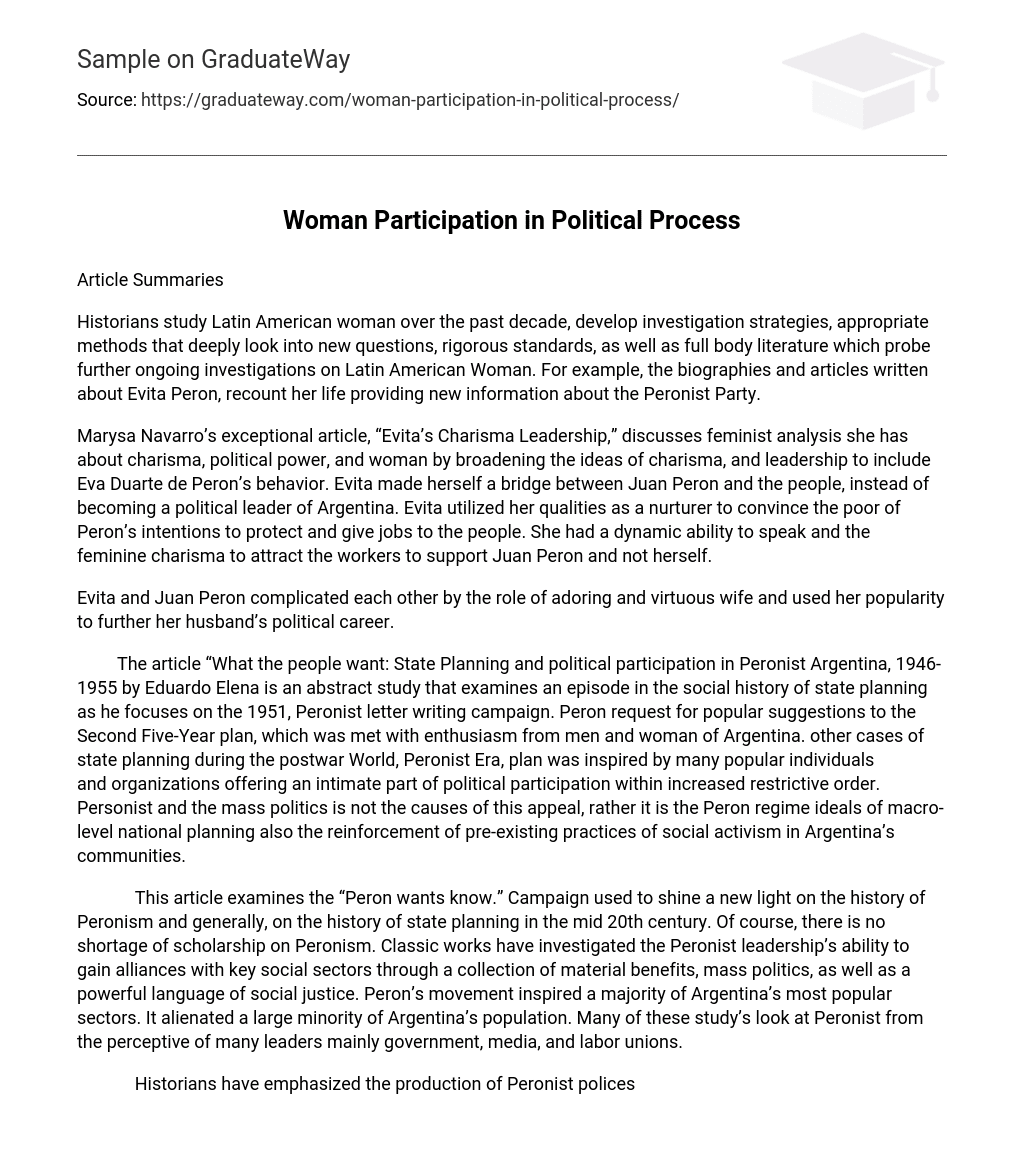Historians study Latin American woman over the past decade, develop investigation strategies, appropriate methods that deeply look into new questions, rigorous standards, as well as full body literature which probe further ongoing investigations on Latin American Woman. For example, the biographies and articles written about Evita Peron, recount her life providing new information about the Peronist Party.
Marysa Navarro’s exceptional article, “Evita’s Charisma Leadership,” discusses feminist analysis she has about charisma, political power, and woman by broadening the ideas of charisma, and leadership to include Eva Duarte de Peron’s behavior. Evita made herself a bridge between Juan Peron and the people, instead of becoming a political leader of Argentina.
Evita utilized her qualities as a nurturer to convince the poor of Peron’s intentions to protect and give jobs to the people. She had a dynamic ability to speak and the feminine charisma to attract the workers to support Juan Peron and not herself. Evita and Juan Peron complicated each other by the role of adoring and virtuous wife and used her popularity to further her husband’s political career.
The article “What the people want: State Planning and political participation in Peronist Argentina, 1946-1955 by Eduardo Elena is an abstract study that examines an episode in the social history of state planning as he focuses on the 1951, Peronist letter writing campaign. Peron request for popular suggestions to the Second Five-Year plan, which was met with enthusiasm from men and woman of Argentina. other cases of state planning during the postwar World, Peronist Era, plan was inspired by many popular individuals and organizations offering an intimate part of political participation within increased restrictive order. Personist and the mass politics is not the causes of this appeal, rather it is the Peron regime ideals of macro-level national planning also the reinforcement of pre-existing practices of social activism in Argentina’s communities.
This article examines the “Peron wants know.” Campaign used to shine a new light on the history of Peronism and generally, on the history of state planning in the mid 20th century. Of course, there is no shortage of scholarship on Peronism. Classic works have investigated the Peronist leadership’s ability to gain alliances with key social sectors through a collection of material benefits, mass politics, as well as a powerful language of social justice. Peron’s movement inspired a majority of Argentina’s most popular sectors. It alienated a large minority of Argentina’s population. Many of these study’s look at Peronist from the perceptive of many leaders mainly government, media, and labor unions.
Historians have emphasized the production of Peronist polices over their reception and adaptation by individuals, because of the difficulty of gaining access to sources on the 1946-1955 Era. Eduardo Elena article does not ignore the asymmetries of the power between state authorities and the popular sector Argentines. This article turns away from the “top-down” methodology of many studies. For example: the essay investigates how the Peronist version of planned progress agreed with many working and middle class Argentines, and as a result these actors identified their personal goals with priorities of the state. This approach employed fascinating documents which consists of the letters sent by the Argentine’s to Peron’s government.
The article also focuses on a rich subset of correspondence which consists of those letters that concern public works to address a central question: Why did Peronist planning have a popular appeal? The article answers this question by stating that the allure of planning is that the letter writers were aware of the Peronist state accomplishments. The public works projects is considered the most tangible evidence of planning state in action were constructed across Argentina and were the subject of extensive print, radio, as well as propaganda. The costs associated with the participation in the “Peron Wants to know,” event was small and the potential gain for petitioners were great.
The next article I am going to summarize is “The Life and the Co modification of Death in Argentina: Juan and Eva Peron by Donna J. Guy. The article discusses the personal regimes of Juan Peron in an era Of Populism. He uses familial and patriarchal symbolism as metaphors Of state rule. In Argentina Peron was hailed as the father of the country despite the fact he initially cast himself as the leader of a fraternal republic. He rebelled against the old father’s, the oligarchs and could claim to be a revolutionary in attacking the ancient regime by celebrating demotic values and social justice.
In Eva Peron, Argentina as well as Juan Peron acquired a formidable accomplice. She redefined woman’s citizenship so as to have woman participate in every political process while at the same time still keeping the meaning of female political incorporation within the known terms of femininity. Eva Peron, died of cancer in 1952. She was considered a Saint to the poor while others believed she and Juan Peron did nothing to help Argentina at all.
Works Cited
- Elizabeth Dore, Maxine Molyneux; Duke University Press, 2000- Hidden histories of Gender and the state in Latin America- Article excerpt- Life and the co modification of Death in Argentina: Juan and Eva Peron by Donna J. Guy WWW.Questia.com- Online Encyclopedia.
- Marysa Navarro, Evita’s Charismatic Leadership-1977- WWW.Questia.com
- Eduardo, Elena; What the people want: State Planning and Political
- Participation in Peronist Argentina, 1946-1955; 2005 WWW.journals.cambridge.org





